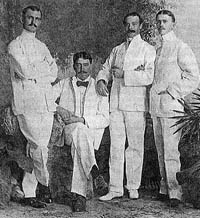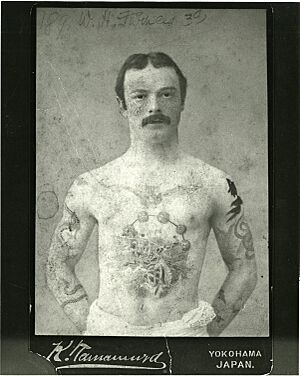William Henry Furness III facts for kids
William Henry Furness III (born August 10, 1866 – died August 11, 1920) was an American doctor, a person who studies cultures (ethnographer), and an author from Philadelphia, Pennsylvania. He traveled many times to the South Pacific. He was one of the first people to study and photograph the Kayan people of Borneo and the Wa'ab people on Yap island.
Contents
Who Was William Henry Furness III?
William Henry Furness III came from a famous family. His grandfather, also named William Henry Furness, was a well-known religious leader. His father, Horace Howard Furness, was a famous expert on Shakespeare.
William Henry Furness III went to St. Paul's School and Harvard University. He then studied medicine at the University of Pennsylvania Medical School, graduating in 1891. He was even in a famous painting called The Agnew Clinic by Thomas Eakins, which shows medical students.
Exploring Distant Lands
Between 1895 and 1901, Furness went on four big trips to Southeast Asia and Oceania. He traveled with his friends, Hiram M. Hiller, Jr. and Alfred C. Harrison, Jr. They collected many interesting things. These included cultural items, old artifacts, and bones. Furness and Harrison also took many photographs.
These collections became some of the first items at the University of Pennsylvania Museum of Archaeology and Anthropology. They also gave animal specimens, like fish and birds, to the Academy of Natural Sciences of Philadelphia. Some duplicate items went to the Peabody Museum of Archaeology and Ethnology at Harvard University.
Studying the Wa'ab People and Stone Money
In 1903, Furness returned to the South Pacific. He spent two months with the Wa'ab people on the island of Uap (now called Yap). He wrote about their special money, called rai stones. These were large, doughnut-shaped stones made of limestone.
Yap is a coral island, so it doesn't have natural stone. Most of the rai stones came from Palau, an island about 280 miles (450 kilometers) away. A rai stone about 1 foot (30.5 cm) wide could buy a full-grown pig. Some of these stones were huge, up to 12 feet (3.66 meters) across!
Rai stones were valuable because they showed how much hard work went into them. They had to be dug up and carved in Palau. Then, they were transported hundreds of miles by canoe or raft. On Yap, it took about twenty men to move the largest stones. Furness also used a special machine called a phonograph to record the Wa'ab people's speech and songs. He even created the first dictionary that translated between the Uapese language and English.
Furness worked as a curator for the University of Pennsylvania Museum's general ethnology section from 1903 to 1905. A curator is someone who manages and cares for a museum's collections.
Recognitions and Achievements
William Henry Furness III was recognized for his important work. He became a member of the American Philosophical Society in 1897. In 1898, he became a fellow of the Royal Geographical Society. He also became a fellow of the Royal Anthropological Institute of Great Britain and Ireland in 1902. These are all important groups that recognize experts in different fields.
Furness's Personal Life
An article from 1894 said Furness was "the most artistically tattooed man in the world." It reported that he got many tattoos during a long trip to Japan. He had a goddess on his chest and a god on his back. Snakes and birds covered his arms and legs. He also had a pagoda and other designs on his shoulders, and a Chinese boat and a dragon on his legs.
His father paid for his expeditions. His mother had inherited a lot of money from an iron-making business, and his father was a successful author. Furness never married. He lived at "Lindenshade," his parents' house in Wallingford.
He helped illustrate a book called String Figures and How to Make Them (1906). This book was written by his sister, Caroline Furness Jayne, who also studied cultures. After Caroline and her husband died, their teenage children, Kate and Horace H. F. Jayne, lived with Furness at "Lindenshade."
During World War I, Furness served as a captain in the U.S. Army Medical Corps. He helped organize the distribution of medical supplies. He also donated the land for the Helen Kate Furness Free Library in Wallingford, named after his mother. He started to collect and edit his father's letters, but he became too sick to finish. His nephew Horace completed the project.
William Henry Furness III is buried in the Furness family plot at Laurel Hill Cemetery in Philadelphia.
Furness's Published Works
- "Glimpses of Borneo," Proceedings of the American Philosophical Society, vol. 35 (1897).
- Life in the Luchu Islands (Philadelphia: 1899).
- Folk-Lore in Borneo: A Sketch (Wallingford, Pennsylvania: 1899).
- The Home-Life of Borneo Head-Hunters: Its Festivals and Folk-Lore (Philadelphia: J. B. Lippincott Company, 1902).
- (Co-authored with H. M. Hiller, Jr.) Notes of a Trip to the Veddahs of Ceylon (London, 1902).
- "The Stone Money of Uap, West Caroline Islands," Transactions of the Department of Archaeology, University of Pennsylvania Museum, vol. 1, no. 1 (1904).
- The Island of Stone Money, Uap of the Carolines (Philadelphia: J. B. Lippincott Company, 1910).
- "A Visit to a Head-Hunter of Borneo, 1901," The World's Story: A History of the World in Story, Song and Art, Volume 1: China, Japan, and the Islands of the Pacific (Boston: Houghton Mifflin, 1914).
- "Observations on the Mentality of Chimpanzees and Orang-utans," Proceedings of the American Philosophical Society, vol. 55, no. 3 (April 1916).
Images for kids
-
The Agnew Clinic (1889) by Thomas Eakins. Furness is in the top row, center, leaning far to the side.









